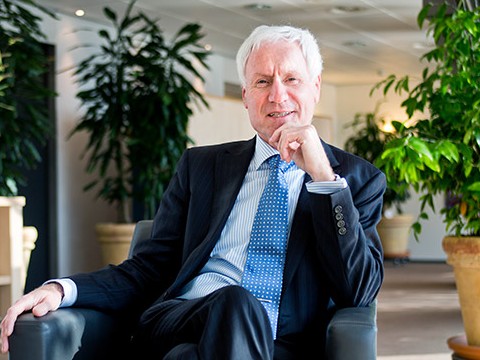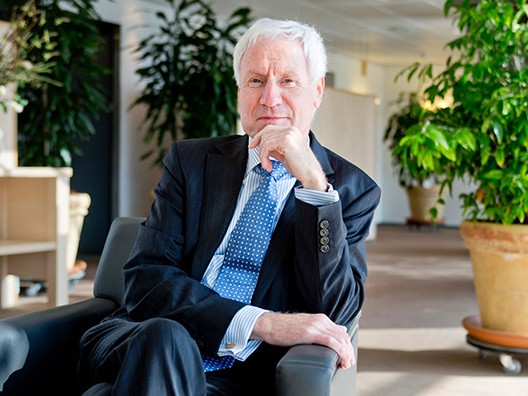
Livestock farming and meat production in The Netherlands must stay on the path to greater sustainability. It is an objective that has wide support in the industry, but it is also an ambitious one, and one that cannot be achieved overnight. Jos Goebbels, chairman of the Dutch Meat Association (COV), talks about the achievements in recent years and the key strategies for the future.
The meat sector is changing. In today’s society increasing conditions are being placed on the supply of meat. Meat is still a staple of the main meal in many households, but it is no longer automatically on the menu. “Moving to sustainable, animal-friendly meat is more difficult than many people realise, particularly when the aim is to bring about change in an entire sector,” said the Van Doorn Committee in its ‘Making all meat sustainable’ report published in 2011. ”Creating the conditions in which a livestock farmer can keep his animals in a socially accepted way requires a transformation – not only in livestock farming, but also in society as a whole,” states the report. Four years on, that transformation into a sustainable meat sector has begun.
“As an umbrella organisation, the COV has its own vision of sustainability for the meat sector,” says Jos Goebbels. “The animal production chain is increasingly aware of its position in society, the importance of society’s support and the importance of closing the loops. Sustainability in the meat sector is focused on setting up the production chain in such a way as to minimise the burden that is ‘passed on’; in other words using as much of the animal as possible for human consumption and countering food waste. We strive to be economical with natural resources such as soils, ecosystems and minerals. The animal’s welfare is also taken into account. This pursuit of sustainability is expressed in genuine concern for the three Ps: people, profit and planet.”
Goebbels: “Responsible soya is of particular benefit to the farmer and to sustainability in producing countries; that is why we choose it. Soya is used particularly in pig feed. The COV has a cooperation agreement with Nevedi (the Dutch association for the animal feed industry, Ed.) and the supplier agreements with the animal feed and livestock industries have been included in chain quality systems. Switching to 100%-responsible soya in 2015 was an important common criterion in the central purchasing conditions of the Dutch supermarket association (CBL) as part of the ‘Pigs of Tomorrow’ programme. From 2015 the Dutch animal feed industry is using only sustainable (RTRS-certified) soya. That means our objective has been achieved – at least, as far as pigs in the Netherlands are concerned; we have no say over piglets and pigs exported abroad. Our ambition, however, is that pork intended for export should be included in the project. The sticking point is that foreign countries do not demand pigs fed on sustainable soya. The Netherlands is a clear leader in this field.”
‘We believe that accelerating the sustainability of pork production is the best recipe for the future’
“In March 2012, the COV joined forces with four industry organisations in the meat sector to draw up a ‘Roadmap for Meat, towards an energy-efficient meat sector’ (www.routekaartvlees.nl). It examined how the sector could achieve an energy saving of 30% to 50% in 2030 and take steps towards the use of sustainable energy and optimum recycling of residual flows. An energy saving of 20% to 50% can be achieved, for example, through smarter cooling of production sites using highly advanced controls. It is possible to heat cleaning water to 75 degrees by collecting heat from refrigeration systems. There is also a great deal of interest in so-called ‘high-care incubators’ in the processing industry. This is a form of process refrigeration: you cool the process, not the entire room. This will generate major energy gains in the medium term. It will also provide a much less cold and hence more pleasant working environment for personnel. Companies can take advantage of the practical possibilities presented in the report to achieve the environmental objectives. We still hold regular sessions with companies to keep each other up to date, but it is up to the companies to take steps.”
“Workshops and network meetings were organised in the preliminary stage of the ‘Roadmap for Meat’. During those meetings useful contacts were established between members of the COV and, for example, engineering firms,” Goebbels continues. “Two large slaughterhouses which are currently engaged in new construction work are benefiting from this: Hutten Vlees in Nieuw Heeten and the newly merged Westfort in IJsselstein have incorporated the latest energy- and water-conservation technologies in the plant. The Dutch meat sector is on the right track. Pork, veal and poultry meat chains have made energy savings amounting to dozens of percent over the past few decades and also substantially reduced their greenhouse gas emissions. The Netherlands is among the world leaders in this field, but there are still plenty of opportunities for further improvement,” says Goebbels. “TNO, for example, provides a means of monitoring temperature patterns and possible bacteria growth in the transporting of non-fully cooled beef and veal carcasses.” (You can read more about the TNO research in the October 2014 edition of Food in Business, Ed.).
'Our ambition is to be a global leader in sustainability’
“More and more inspiring examples are emerging. For example, the Government Advisor on Landscape, Yttje Feddes, looked at six innovative pigsties, all of which met the requirements of the Yardstick of Sustainable Livestock Farming. Among them is a winner (Blokhoven in Schalwijk), which has sties with solar panels around a central yard for the pigs. There is the integrated, sustainable ‘roundhouse’ sty (Veldhoekporc in Lemerlerveld), which is similar to the familiar Roundel housing system in the poultry sector. Another notable example is De Uitspanning in Voorthuizen, a somewhat larger company, which uses terraces and phasing in production; there are various visitor and recreational facilities. The ideas were assessed with a very open-minded attitude so that the larger farms and sty concepts with additional storeys could likewise become more sustainable.”
Another example is animal-friendly livestock transportation promoted by the VanDrie Group. “A fully air-conditioned Comfort Class livestock truck has been developed jointly with a truck manufacturer. Calves being transported in the truck are then exposed as little as possible to temperature fluctuations. The trucks also have cameras, so the drivers can monitor the calves’ behaviour during the journey. The animals are less susceptible to disease during the first few days on the veal farm, which in turn has a favourable impact on the use of veterinary medicines.”
“Enormous steps have been taken in recent years to increase sales to regions such as China, Asia and South America,” says Goebbels. “Pigs’ trotters and ears, for example, for which there is no demand in Europe, no longer go to be processed as animal by-products for animal feed or technical uses, but go to China instead. Our recently launched website www.porkfromholland.com helps promote exports of Dutch pork. So as to discard as little as possible, we also support research into the lengthening of shelf life and better packaging with indicators showing whether the meat is still fit to eat. We are far from exhausting the possibilities. Cleaner working, better refrigeration; a lot has been achieved, but we are not there yet.”
“We’re also an employer’s organisation, which people sometimes forget. The meat sector employs around 12,000 people in almost 300 companies. Approximately 9,000 of those employees are covered by the collective labour agreement for the meat sector. Under a ‘generally binding declaration’, the terms of this collective labour agreement also apply to the other meat processing businesses that are not members. So it really does involve a lot of people.”
“The sustainable deployment of these employees is a particular challenge in the meat sector,” he continues. “It often involves physical work, in many cases in refrigerated environments. Moreover, many people in this sector began their career at a young age. We’ve worked with the trade unions to develop an occupational health & safety catalogue for the meat industry. This surveys the risks and specifies control measures and best practices. A number of subjects have received particular attention, such as RSI, machine safety and pressure of work. We consult regularly with the trade unions, government and other stakeholders about developments in the labour market and important matters such as working conditions, flexible employment and training for the permanent and flexible workforce. Major steps have also been taken recently in the field of long-term flexible working, sustainable continued work for older people and continuous learning.”
“We believe that accelerating the sustainability of pork production is the best recipe for the future,” says Goebbels. “This ambition has consequences for all parts of the production chain: for pig farming, the supply industry, slaughterhouses, meat processing, transport, retail and foodservice. Increased sustainability of pork production must be tackled on a broad front, jointly with the supermarkets. The State Secretary has offered to facilitate this policy where necessary. Our ambition is to be a global leader in sustainability,” he says in conclusion. “We cannot do that alone; collaboration is essential!”

Jos Goebbels has occupied various posts including director of the Flower Bulb Inspection Service (PKD) and director of Supervision Policy and Communication at the Netherlands Food and Consumer Product Safety Authority (VWA). Since September 2009 he has chaired the Dutch Meat Association (COV), which represents the collective interests of employers in the Dutch meat sector, both nationally and internationally. The members of the COV jointly account for over 90% of total Dutch meat revenues. There are also associate members, including Darling, VSV and a number of employer organisations. Including its own members, over 150 businesses are directly or indirectly affiliated with the COV.
Source: © Jeroen Poortvliet